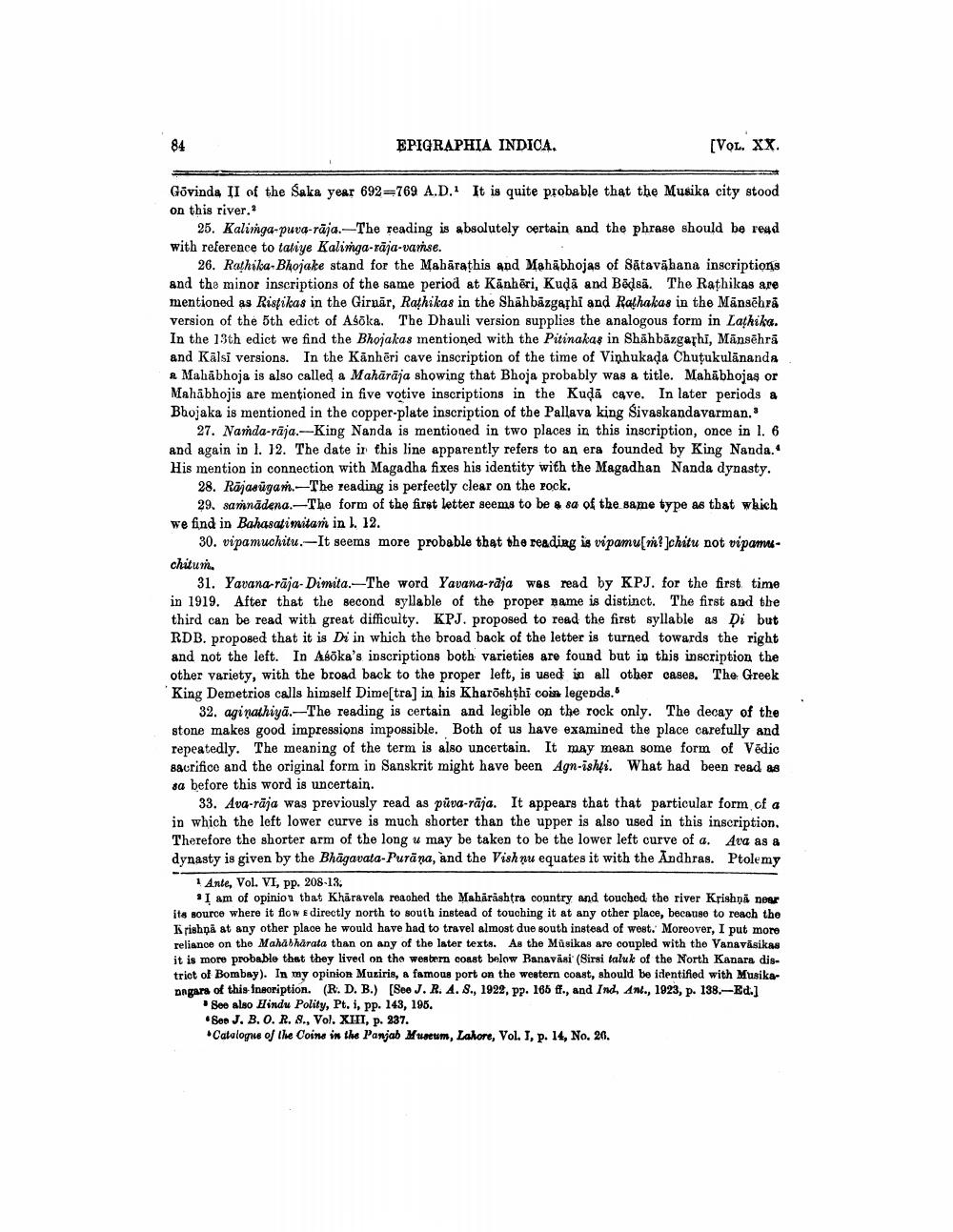________________
EPIGRAPHIA INDICA.
[VOL. XX.
Govinda II of the Saka year 692=769 A.D. It is quite probable that the Musika city stood on this river.
25. Kalinnga-puva-raja.The reading is absolutely certain and the phrase should be read with reference to tatiye Kalimga-tāja-varse.
26. Rathika-Bhojake stand for the Mahārathis and Mahābhojas of Sātavāhana inscriptions and the minor inscriptions of the same period at Kānhēri, Kudā and Bēds. The Rathikas are mentioned as Ristikas in the Girpār, Rathikas in the Shāh bāzgashi and Rathakas in the Mānsēhra version of the 5th edict of Asoka. The Dhauli version supplies the analogous form in Lathika. In the 13th edict we find the Bhojakas mentioned with the Pitinakae in Shāhbāzgashi, Mānsēhrā and Kālsi versions. In the Kānhēri cave inscription of the time of Vinhukada Chuţukulānanda A Mahābhoja is also called a Mahārāja showing that Bhoja probably was a title. Mahābhojas or Mahābhojis are mentioned in five votive inscriptions in the Kuda cave. In later periods a Bhojaka is mentioned in the copper-plate inscription of the Pallava king Sivaskandavarman.'
27. Namda-rāja.--King Nanda is mentioned in two places in this inscription, once in l. 6 and again in l. 12. The date in this line apparently refers to an era founded by King Nanda. His mention in connection with Magadha fixes his identity with the Magadhan Nanda dynasty,
28. Rājasügan.-The reading is perfectly clear on the rock.
29. sarinadena.-The form of the first letter seems to be a sa of the same type as that which we find in Bahasatimitam in l. 12.
30. vipamuchitu.-It seems more probable that the reading is vipamu[m?]chitu not vipamuschitun.
31. Yavana-rāja-Dimita.-The word Yavana-raja was read by KPJ. for the first time in 1919. After that the second syllable of the proper name is distinct. The first and the third can be read with great difficulty. KPJ. proposed to read the first syllable as Di but RDB. proposed that it is Di in which the broad back of the letter is turned towards the right and not the left. In Aboka's inscriptions both varieties are found but in this inscription the other variety, with the broad back to the proper left, is used in all other cases. The Greek King Demetrios calls himself Dime[tra) in his Kharöshthi coin legends.
32. aginathiya.-The reading is certain and legible on the rock only. The decay of the stone makes good impressions impossible. Both of us have examined the place carefully and repeatedly. The meaning of the term is also uncertain. It may mean some form of Vēdio sacrifice and the original form in Sanskrit might have been Agn-ishti. What had been read as sa before this word is uncertain.
33. Ava-rāja was previously read as pūva-tāja. It appears that that particular form of a in which the left lower curve is much shorter than the upper is also used in this inscription. Therefore the shorter arm of the long u may be taken to be the lower left curve of a. Ava as a dynasty is given by the Bhagavata-Purāna, and the Vishnu equates it with the Andhras. Ptolemy
1 Ante, Vol. VI, pp. 208-13,
? I am of opinion that Khåravela reached the Maharashtra country and touched the river Krishna near ita source where it flow e directly north to south instead of touching it at any other place, because to reach the Irishni at any other place he would have had to travel almost due south instead of west. Moreover, I put more reliance on the Mahabharata than on any of the later texts. As the Musikas are coupled with the Vanavasikas it is more probable that they lived on the western coast below Banavasi (Sirsi taluk of the North Kanara district of Bombay). In my opinion Muziris, a famous port on the western coast, should be identified with Musikapagara of this ineoription. (R. D. B.) [See J. R. A. 8., 1922, pp. 165 ff., and Ind, Ant., 1923, p. 138.-Ed.]
See also Hindu Polity, Pt. i, pp. 143, 195. See J. B.O.R. 8., Vol. XIII, p. 237. Catalogue of the Coins in the Panjab Mteum, Lahore, Vol. I, p. 14, No. 26.




